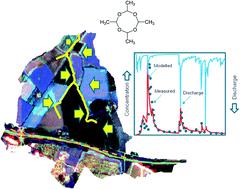当前位置:
X-MOL 学术
›
Environ. Sci.: Processes Impacts
›
论文详情
Our official English website, www.x-mol.net, welcomes your
feedback! (Note: you will need to create a separate account there.)
A new conceptual model of pesticide transfers from agricultural land to surface waters with a specific focus on metaldehyde.
Environmental Science: Processes & Impacts ( IF 4.3 ) Pub Date : 2020-04-29 , DOI: 10.1039/c9em00492k M J Whelan 1 , A Ramos , R Villa , I Guymer , B Jefferson , M Rayner
Environmental Science: Processes & Impacts ( IF 4.3 ) Pub Date : 2020-04-29 , DOI: 10.1039/c9em00492k M J Whelan 1 , A Ramos , R Villa , I Guymer , B Jefferson , M Rayner
Affiliation

|
Pesticide losses from agricultural land to water can result in the environmental deterioration of receiving systems. Mathematical models can make important contributions to risk assessments and catchment management. However, some mechanistic models have high parameter requirements which can make them difficult to apply in data poor areas. In addition, uncertainties in pesticide properties and applications are difficult to account for using models with long run-times. Alternative, simpler, conceptual models are easier to apply and can still be used as a framework for process interpretation. Here, we present a new conceptual model of pesticide behaviour in surface water catchments, based on continuous water balance calculations. Pesticide losses to surface waters are calculated based on the displacement of a limited fraction of the soil pore water during storm events occurring after application. The model was used to describe the behaviour of metaldehyde in a small (2.2 km2) under-drained catchment in Eastern England. Metaldehyde is a molluscicide which has been regularly detected at high concentrations in many drinking water supply catchments. Measured peak concentrations in stream water (to about 9 μg L-1) occurred in the first few storm events after application in mid-August. In each event, there was a quasi-exponential decrease in concentration during hydrograph recession. Peak concentrations decreased in successive events - responding to rainfall but reflecting an effective exhaustion in soil supply due to degradation and dissipation. Uncertain pesticide applications to the catchment were estimated using land cover analysis of satellite data, combined with a Poisson distribution to describe the timing of application. Model performance for both the hydrograph (after calibration of the water balance) and the chemograph was good and could be improved via some minor adjustments in assumptions which yield general insights into the drivers for pesticide transport. The use of remote sensing offers some promising opportunities for estimating catchment-scale pesticide applications and associated losses.
中文翻译:

一种新的概念性农药模型,从农用土地转移到地表水,重点关注甲醛。
农用土地上的农药流失会导致接收系统的环境恶化。数学模型可以为风险评估和集水区管理做出重要贡献。但是,某些机械模型对参数的要求很高,这可能使其难以应用于数据贫乏的地区。此外,很难使用长时间运行的模型来解释农药特性和应用方面的不确定性。替代的,更简单的概念模型更易于应用,并且仍可以用作过程解释的框架。在这里,我们基于连续的水平衡计算,提出了一种新的概念性模型,用于在地表水流域中的农药行为。农药对地表水的损失是根据施用后发生的暴风雨期间土壤孔隙水中有限部分的位移来计算的。该模型用于描述英格兰东部一个小面积(2.2 km2)排水不足的流域中甲醛的行为。甲醛是一种杀软体动物剂,已在许多饮用水供应流域中定期检测到高浓度的甲醛。在8月中旬施药后的头几场暴风雨中,溪流水中的峰值浓度达到了约9μgL-1。在每种情况下,水位仪衰退期间浓度均呈准指数下降。峰值浓度在连续的事件中降低-对降雨作出反应,但反映出由于退化和消散,土壤供应有效枯竭。通过对卫星数据进行土地覆盖分析并结合泊松分布来描述施药时间,估算出该流域的不确定农药施用量。水位计(校准水平衡后)和化学扫描仪的模型性能都很好,可以通过对假设进行一些细微调整来改善模型,这些假设可以使人们对农药运输的驱动因素有全面的认识。遥感的使用为估计流域规模的农药施用量和相关损失提供了一些有希望的机会。水文图(校准水平衡后)和化学图的模型性能都很好,可以通过对假设进行一些细微调整来提高模型的假设,从而对农药运输的驱动因素有一般的认识。遥感的使用为估计流域规模的农药施用量和相关损失提供了一些有希望的机会。水文图(校准水平衡后)和化学图的模型性能都很好,可以通过对假设进行一些细微调整来提高模型的假设,从而对农药运输的驱动因素有一般的认识。遥感的使用为估计流域规模的农药施用量和相关损失提供了一些有希望的机会。
更新日期:2020-02-04
中文翻译:

一种新的概念性农药模型,从农用土地转移到地表水,重点关注甲醛。
农用土地上的农药流失会导致接收系统的环境恶化。数学模型可以为风险评估和集水区管理做出重要贡献。但是,某些机械模型对参数的要求很高,这可能使其难以应用于数据贫乏的地区。此外,很难使用长时间运行的模型来解释农药特性和应用方面的不确定性。替代的,更简单的概念模型更易于应用,并且仍可以用作过程解释的框架。在这里,我们基于连续的水平衡计算,提出了一种新的概念性模型,用于在地表水流域中的农药行为。农药对地表水的损失是根据施用后发生的暴风雨期间土壤孔隙水中有限部分的位移来计算的。该模型用于描述英格兰东部一个小面积(2.2 km2)排水不足的流域中甲醛的行为。甲醛是一种杀软体动物剂,已在许多饮用水供应流域中定期检测到高浓度的甲醛。在8月中旬施药后的头几场暴风雨中,溪流水中的峰值浓度达到了约9μgL-1。在每种情况下,水位仪衰退期间浓度均呈准指数下降。峰值浓度在连续的事件中降低-对降雨作出反应,但反映出由于退化和消散,土壤供应有效枯竭。通过对卫星数据进行土地覆盖分析并结合泊松分布来描述施药时间,估算出该流域的不确定农药施用量。水位计(校准水平衡后)和化学扫描仪的模型性能都很好,可以通过对假设进行一些细微调整来改善模型,这些假设可以使人们对农药运输的驱动因素有全面的认识。遥感的使用为估计流域规模的农药施用量和相关损失提供了一些有希望的机会。水文图(校准水平衡后)和化学图的模型性能都很好,可以通过对假设进行一些细微调整来提高模型的假设,从而对农药运输的驱动因素有一般的认识。遥感的使用为估计流域规模的农药施用量和相关损失提供了一些有希望的机会。水文图(校准水平衡后)和化学图的模型性能都很好,可以通过对假设进行一些细微调整来提高模型的假设,从而对农药运输的驱动因素有一般的认识。遥感的使用为估计流域规模的农药施用量和相关损失提供了一些有希望的机会。











































 京公网安备 11010802027423号
京公网安备 11010802027423号